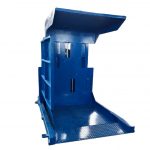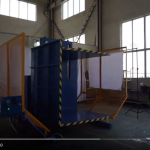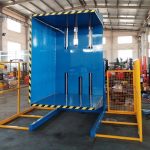Pallet Inverters and Workplace Safety: How to Build a Case for Investment
- Pallet Inverters and Workplace Safety: How to Build a Case for Investment
- 1. Understanding the Role of Pallet Inverters in Safety
- 2. The Dangers of Manual Pallet Handling
- 3. How Pallet Inverters Work
- 4. Building the Business Case for Investment
- 5. Supporting Evidence: Real-World Benefits of Pallet Inverters
- 6. Key Features to Look for When Choosing a Pallet Inverter
- Conclusion: Why Pallet Inverters are a Wise Investment

Pallet inverters are more than just an industrial tool—they are a key investment for enhancing workplace safety and operational efficiency. When looking to improve safety standards and reduce manual handling risks, pallet inverters present a compelling solution that minimizes hazards, streamlines processes, and ultimately drives higher productivity. This article explores how pallet inverters contribute to workplace safety and provides a guide for building a solid case for their investment.
1. Understanding the Role of Pallet Inverters in Safety
At its core, a pallet inverter is designed to flip or rotate heavy pallets and their loads with minimal human intervention. This reduces the need for workers to perform manual pallet handling, which is often labor-intensive and risky. Injuries related to manual pallet handling are prevalent in sectors like warehousing, logistics, and manufacturing, where workers are frequently exposed to tasks like pallet loading, unloading, and repositioning.
The Occupational Safety and Health Administration (OSHA) reports that overexertion from lifting and repetitive movements contributes significantly to workplace injuries. By integrating pallet inverters, companies can mitigate the risk of musculoskeletal disorders, sprains, strains, and accidents, creating a safer work environment.
2. The Dangers of Manual Pallet Handling
To fully understand the value of pallet inverters, it’s essential to recognize the risks associated with manual pallet handling. Lifting and shifting heavy loads expose workers to the following hazards:
- Back Injuries: Repeated bending, twisting, and lifting can lead to chronic back pain and injuries, which are among the most common reasons for absenteeism in manual labor roles.
- Crushing Hazards: Pallets that are improperly handled can tip or collapse, posing crushing risks to nearby workers.
- Slips and Falls: Manual handling often requires workers to move pallets in congested areas, leading to a higher incidence of slips, trips, and falls.
- Strains and Sprains: The repetitive nature of manually moving pallets can result in strains and sprains, particularly in the neck, shoulders, and lower back.
Implementing a pallet inverter dramatically reduces these hazards by automating the heavy lifting and reducing the frequency with which workers need to manually interact with pallets. Automation is crucial in transforming the workplace into a safer, more efficient space.
3. How Pallet Inverters Work
Pallet inverters function by securing a palletized load and rotating it—usually by 180 degrees—so that it can be replaced, inverted, or repositioned as necessary. This process eliminates the need for manual load adjustment and makes it easier to:
- Swap damaged pallets with minimal downtime.
- Rotate perishable goods to facilitate the first-in, first-out (FIFO) inventory system.
- Reorganize stock quickly and efficiently.
The operation of pallet inverters is smooth and reliable, and they can handle various load sizes and weights, providing flexibility for industries with heavy-duty requirements. In essence, these machines automate repetitive tasks, reducing labor requirements and safeguarding the workforce.

Get Your Best Solution !
4. Building the Business Case for Investment
Investing in pallet inverters is not just about improving safety; it’s also about enhancing efficiency and reducing costs. Here’s how you can build a strong case for investing in pallet inverters:
- Reduction in Workplace Injuries: As previously mentioned, pallet inverters can significantly reduce the risk of injury. Fewer injuries mean lower compensation claims, fewer lost workdays, and reduced insurance premiums. Over time, this results in substantial cost savings.
- Increased Productivity: Pallet inverters automate tasks that would otherwise take workers hours to complete manually. This frees up staff to focus on more value-adding activities, increasing overall productivity. With a faster, more efficient process, you can also minimize downtime.
- Long-Term Cost Savings: While the initial investment in pallet inverters may seem substantial, the long-term savings on labor, injury-related costs, and process efficiency can quickly offset the expenditure. The return on investment (ROI) for pallet inverters is often realized within the first few years of use.
- Improved Compliance with Safety Standards: Compliance with OSHA and other safety regulations is non-negotiable. Pallet inverters help ensure that your operations meet these stringent safety standards, avoiding fines and legal consequences. Additionally, by adhering to these safety practices, you enhance your reputation as a company that values employee well-being.
5. Supporting Evidence: Real-World Benefits of Pallet Inverters
To further strengthen your case, it’s helpful to look at real-world examples where pallet inverters have made a significant impact. Many companies that have adopted pallet inverters report the following benefits:
- Faster Pallet Replacements: Companies with high inventory turnover have experienced a noticeable reduction in pallet replacement times. This helps maintain workflow consistency and reduces the time spent on non-value-adding tasks.
- Safer Work Environment: Organizations in industries such as food and beverage, pharmaceuticals, and logistics have seen reduced incidents of workplace injuries. In some cases, injury rates have dropped by over 50% after implementing pallet inverters, contributing to a healthier and safer work environment.
- Reduction in Product Damage: With automated handling, the risk of product damage during pallet transfer decreases. This results in fewer lost goods and reduced waste, especially in delicate or high-value products.
These benefits underline the value of pallet inverters in creating a more efficient and safer workplace, further justifying the investment.
6. Key Features to Look for When Choosing a Pallet Inverter
When selecting a pallet inverter, it’s essential to consider features that align with your operational needs. Key features include:
- Load Capacity: Ensure that the inverter can handle the maximum load your facility works with. The last thing you want is to invest in a machine that doesn’t meet your weight requirements.
- Rotation Capabilities: Depending on your industry, you may need a pallet inverter that offers more than just a 180-degree rotation. Some machines allow for partial or full rotations, catering to different material handling needs.
- Safety Features: Look for pallet inverters with built-in safety mechanisms such as load clamps, secure grips, and emergency stop buttons. These features provide additional layers of protection for both the operator and the products being handled.
- Customization Options: Many manufacturers offer customizable pallet inverters that can be tailored to your specific operational requirements. Customization can include adjustments to height, rotation speed, or integration with other automated systems within your facility.
By selecting a pallet inverter that fits your needs, you can ensure optimal performance and maximize the benefits in both safety and efficiency.
Conclusion: Why Pallet Inverters are a Wise Investment
Pallet inverters offer a multifaceted solution to many common challenges in warehouse and material handling environments. From improving workplace safety by reducing the risks associated with manual handling to enhancing operational efficiency, the advantages are clear. When making the case for pallet inverter investment, focus on the reduction of workplace injuries, cost savings, increased productivity, and compliance with safety standards. By presenting these benefits in a detailed, data-driven manner, decision-makers are more likely to see the value and approve the investment.
In today’s competitive market, investing in safety-enhancing technologies like pallet inverters is not just a choice—it’s a necessity. By doing so, companies can protect their workforce, optimize processes, and ultimately, improve their bottom line.

Get Your Best Solution !








